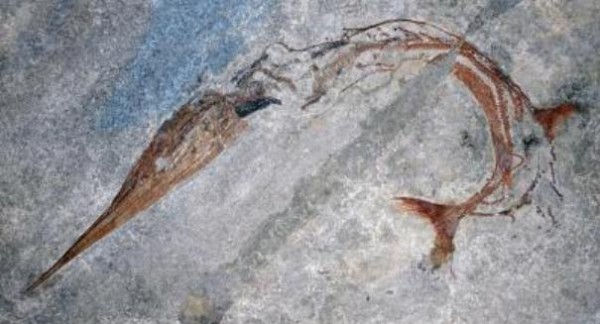Scientists Discover 300 Million Year-old Fossilized Fish Eye
| Marco Foronda | | Dec 24, 2014 06:22 AM EST |
(Photo : Tanaka et al., Nature Communications) Fossilised Acanthodes bridgei with eye tissues intact.
Scientists have discovered a fossilized fish eye so well preserved its insides are still visible under a scanning electron microscope.
The scan reveals eye cells that have existed for at least 300 million years and that have seen the colors of the prehistoric world. It's also the very first time that fossilized photoreceptors from a vertebrate eye have ever been found.
Like Us on Facebook
The cells that line the retina of our eyes are called rods and cones. Rods are long and thin, and more sensitive to light than cones. Cones, which are triangular, allow us to see in color.
Rods are responsible for peripheral and night vision. Cones help perceive fine detail and rapid changes. Both these cells rely on pigments to absorb light.
Using chemical analysis, scientists found evidence of one of these pigments, melanin, in the fossilized eye, as well.
The 300 million year-old fish fossil with its eye tissue is probably one of the earliest known creatures with a backbone.
Scientists examined the fossil specimen of a fish called Acanthodes bridgei. They discovered the fish in Kansas and kept it at the National Museum of Nature and Science in Tokyo.
The fish is about four inches longs and is the last known common ancestor of modern jawed fish like barracudas and sharks.
Scientists also discovered granules the size and shape of particles found in modern fish eyes. These granules are made of eumelanin, a pigment that absorbs light and helps animals see.
Gengo Tanaka of Kumamoto University in Japan, the lead author of the paper, said that studying this fish species can help in reconstructing the colors of extinct animals.
TagsFossilized Fish Eye, Ancient fish, Fossil, animal fossil, Acanthodes bridgei, modern jawed fish, barracudas, sharks, animal extinction, eyes retina
©2015 Chinatopix All rights reserved. Do not reproduce without permission
EDITOR'S PICKS
-

Did the Trump administration just announce plans for a trade war with ‘hostile’ China and Russia?
-

US Senate passes Taiwan travel bill slammed by China
-

As Yan Sihong’s family grieves, here are other Chinese students who went missing abroad. Some have never been found
-

Beijing blasts Western critics who ‘smear China’ with the term sharp power
-

China Envoy Seeks to Defuse Tensions With U.S. as a Trade War Brews
-

Singapore's Deputy PM Provides Bitcoin Vote of Confidence Amid China's Blanket Bans
-

China warns investors over risks in overseas virtual currency trading
-

Chinese government most trustworthy: survey
-

Kashima Antlers On Course For Back-To-Back Titles
MOST POPULAR
LATEST NEWS
Zhou Yongkang: China's Former Security Chief Sentenced to Life in Prison

China's former Chief of the Ministry of Public Security, Zhou Yongkang, has been given a life sentence after he was found guilty of abusing his office, bribery and deliberately ... Full Article
TRENDING STORY

China Pork Prices Expected to Stabilize As The Supplies Recover

Elephone P9000 Smartphone is now on Sale on Amazon India

There's a Big Chance Cliffhangers Won't Still Be Resolved When Grey's Anatomy Season 13 Returns

Supreme Court Ruled on Samsung vs Apple Dispute for Patent Infringement

Microsoft Surface Pro 5 Rumors and Release Date: What is the Latest?










